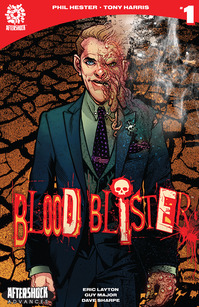Phil Hester on the Body-Rebellion Horror of Blood Blister
“I will get down in the gutter to terrify you.”
Main Art by Tony Harris Comics Features Phil Hester
Let’s talk about monsters. Blood Blister, a new series from writer Phil Hester and artist Tony Harris, has plenty of them: protagonist Brandon Hull is beset by demons and phantasms after entering a haunted house late in the first issue. But Brandon himself isn’t a particularly pleasant character, either. He’s a corrupt lawyer, a sinister figure happy to lead his clients astray with his charisma; he’s neglectful of the people closest to him, and a generally reprehensible guy. All of this, naturally, makes him an ideal candidate for a horror story in which he must confront the corruption inside of him.
The first issue of Blood Blister debuts today from AfterShock Comics.
Paste talked with Hester about the project’s roots, his method of working with Harris and his thoughts on horror storytelling in general. ![]()
Paste: In the first issue of Blood Blister, a lot of different elements converge, from familial drama to moral horror to a a much more visceral horror. Which element came first for you?
Phil Hester: Usually, I’ve been thinking about a project for years and years. I have this big board of things that are never going to happen. [Laughs] I have a big list of things that I want to get to, or “What would I do if I ever got ahold of this character,” that sort of thing. I have a ton of nascent ideas. I’m always looking for a hook in them that will bring a reader in. It’s not necessarily some kind of jive Hollywood high-concept hook—it’s something that rings true to me. I have to have that moment of, Oh, hey! I relate to this! That gives it the momentum I need to go forward.
For me, the momentum definitely came from when I was sick about 18 months ago. I was pretty ill for the first time in my life. I had that idea that my body was not on the same page as my mind, and that was the first time that that had really happened to me. The whole concept of your body betraying you, or your body as your enemy, really took root in my life. That became the hook that I built the story around.
Paste: How did you go from that idea to telling a horror story, as opposed to letting that idea play out in, say, a science fiction context?
Hester: I do a lot of horror stuff. The other big horror things I’ve done were The Coffin and Deep Sleeper, and I did a long run on The Darkness, which I consider a horror series more than an action series. All of those are, on some level or another, about a corrupted character either being redeemed or facing an ultimate punishment for what they’ve done.
To me, the best vehicle for horror is that whole A Christmas Carol dynamic. I know modern horror is kind of nihilistic—everybody dies and there’s no way out. I like stories that can inform people’s lives. I want a story that has that kind of moral hinge to it. That does not preclude me from going for a good gross-out and a good scare. I have a high-minded purpose, but—especially if you read my Darkness run—I will get down in the gutter to terrify you there.

Blood Blister #1 Interior Art by Tony Harris, Eric Layton & Guy Major
Paste: There’s the scene in the first issue where Brandon is draining blood out of his arm, which is incredibly unsettling.
Hester: It’s something you don’t see a lot in horror. I guess you do, in some body horror things, but it’s also something that people do and don’t talk about. People pick their scabs. People are gross. To me, that scene starts playing with the reader’s expectations, both in terms of, Hey, is there something deeper going on with this guy? Is this something that he’s imagining? Is this a subconscious obsession on his part? Is that what’s going on? Or is that a little tiny bit of physical corruption that he can’t stop messing with, that’s the portal to this deeper, darker world of horror that he’s about to plunge into?
Paste: I had a really bad sunburn a few years ago, and I remember describing it to people as “the Cronenbergian horror on my belly.”
Hester: Yeah! Everybody’s been there on some level, even if it’s just an ingrown hair or something. You’ve been repulsed by your own body at some point. His image of himself is so built around success and his physical perfection that that moment of corruption is something that he really can’t shake.
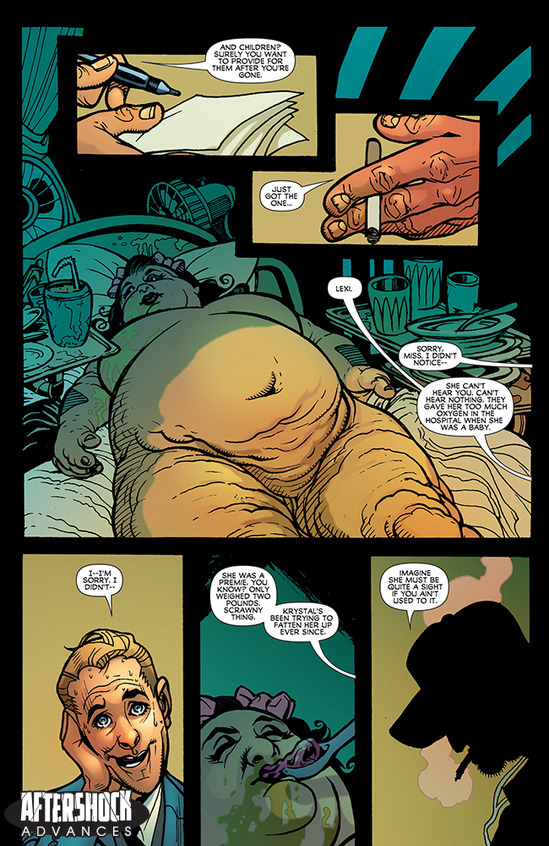
Blood Blister #1 Interior Art by Tony Harris, Eric Layton & Guy Major
Paste: Did you always have Tony Harris in mind for this as an artist? He’s long been an artist who can draw both very attractive people and very grotesque figures with equal skill.
Hester: That’s a bit of luck. The series has had some false starts, and we’ve had other artists attached to it. When Tony showed some interest in it, Joe Pruett at AfterShock and Mike Marts, our editor, we really jumped on it. Like you said, Tony’s really gifted—he can make grotesque things really fun and elaborate to look at. They become almost graceful. By the same token, he can take things that are beautiful and exaggerate them just to the point where they start to become baroque and grotesque themselves. That’s where he lives, in that ambiguity between beauty and grotesquerie. That’s his playground. And that’s really, at least visually, what this series is about. I count my blessings that Tony’s the artist on this, definitely.
Paste: Both of you have done substantial work as both writers and artists. Does that change your working process at all?
Hester: A little bit. I made my bones as an artist first in comics, even though I’ve always done both. It’s just that I really haven’t made a living as a writer until the last 10 or 15 years. Being an artist first had made me very conscious of what I ask of artists when I’m writing a script. I know what’s difficult, what’s rewarding, what’s tedious. When I go in, I’m definitely conscious of what I’m asking artists to do, but also I’m conscious of what they may want to contribute as storytellers. Unless you are Alan Moore, it’s really prohibitive to give one of those really constraining scripts that wants to pick up every last detail of every last shot. Unless you are a master, it’s almost insulting to do that to an artist. As an artist myself, I know to give them some breathing room and let them contribute to the improvisation. It’s almost like being in a jazz trio: you don’t want to run over your partners. You have to let everybody do their solo.
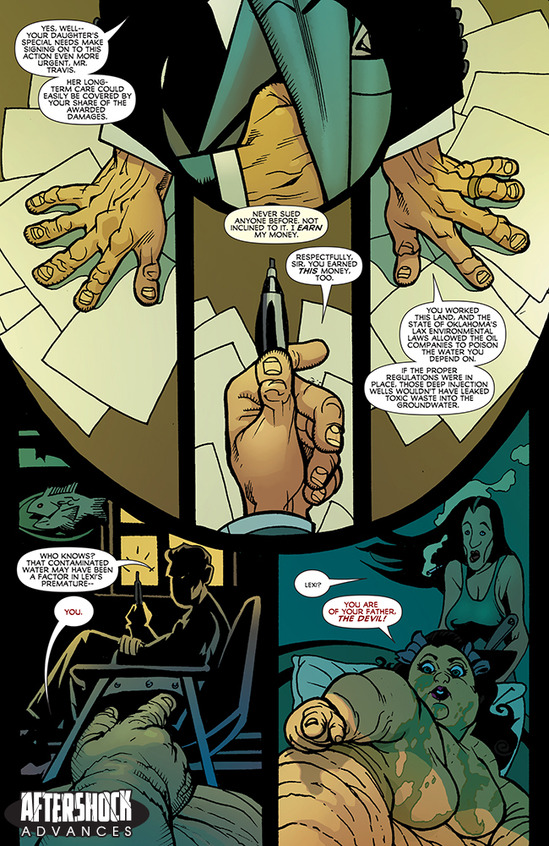
Blood Blister #1 Interior Art by Tony Harris, Eric Layton & Guy Major
Paste: There are references to religious beliefs made throughout the first issue: the protagonist talks about his children being raised Jewish, and the haunted house that appears at the end features religious imagery. Was that to show different characters’ moral compasses, in contrast with the protagonist’s relative amorality?
Hester: There’s not any specific thing I wanted to get to, no specific religious message I wanted to get over. It’s just a way of grounding those characters in real experiences. I realize that we’re playing with a lot of typical possession story tropes. Those are almost always tied up with Catholic, or at least Christian, ideologies and themes and imagery. I wanted to approach those from the standpoint of a character who doesn’t particularly have any kind of religious heritage, and what religious heritage he does have—through his wife and his in-laws and his children—is not Christian. It was important for me to get away from that, because it’s so easy to fall back on that stuff.
Where we do touch on that, it’s always a reflection of the other characters that can see the evil festering in him that he can’t see yet. That’s the lens that they see it through. There’s the Trailer family, who have a Southern Baptist take on things. He sees some other characters later who see him from a Buddhist perspective and a Santería perspective, and they all know that something is wrong with him, but they can’t tell him. It’s because the core theme of the whole book is that the evil that possesses him isn’t from an outside source. He is the source of the demon inside him. He gestates it. He gives birth to it. He’s not some unfortunate victim, some innocent that gets hijacked by a demon. He gives birth to the demon he becomes. So that’s what separates our book from other possession stories.
Paste: In other words, that’s what separates this from something like the Stephen King novel Thinner, where the changes to the protagonist’s body come from an external source?
Hester: Yes. The correction itself is an indicator of what’s going on inside of him. I don’t want to spoil where the story goes, but you get the idea that the effluvia that he is draining from himself has a life of its own. It becomes the physical manifestation of his possession. It’s gross, but it’s cool-looking, because everything Tony draws is cool-looking. And hopefully it’s scary. It’s not a jump-scare book, because jump-scares are almost impossible to do in comics. But it’s an unsettling book. I hope it’s deeply unsettling.
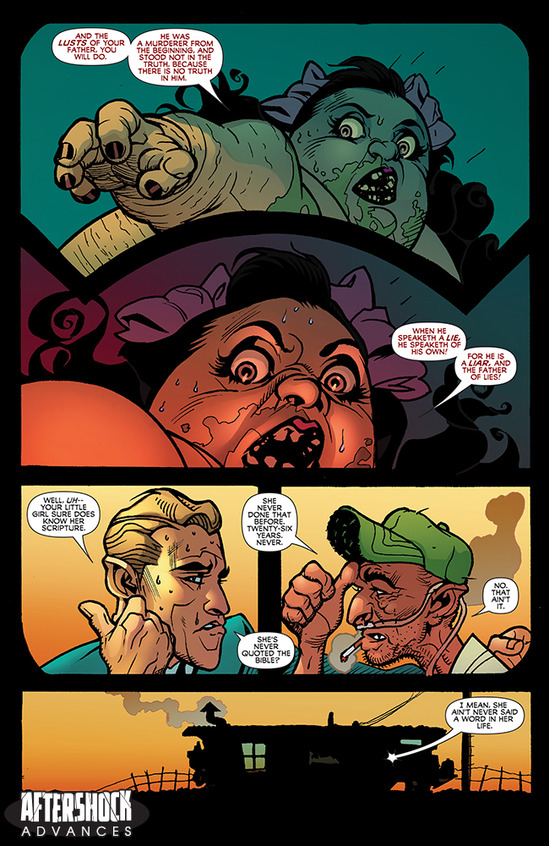
Blood Blister #1 Interior Art by Tony Harris, Eric Layton & Guy Major
Paste: The first issue of Shipwreck also has a lot of disorienting, jarring imagery, so it seems like you’re right in the middle of that right now.
Hester: It’s just a coincidence, I guess. I’m a really happy, well-adjusted person. [Laughs] I guess that’s how we get it out. I’ll never forget it: when The Coffin came out, we had a lot of fans who, when they met Mike and I, were really disappointed. “Oh…..you’re just a couple of dads. You’re normal guys.”
Paste: I remember reading a profile of J.G. Ballard many years ago that mentioned that, in daily life, he lived a very quiet, nondescript existence—not what you’d expect from someone who wrote so much jarring, unsettling fiction.
Hester: If you’re a writer, you have to trust your imagination. Honestly, I like to tie my horror stories in with family things. It’s one thing to be scared for yourself and your own safety, but once you have a family that you care about—even if it’s not your children, if it’s your parents or whatever, if you have a family that you’re close with. True horror is not me worrying about being murdered by a guy with a hook. I can handle that. I can live with that. True horror for me is the idea of my kids being killed by a drunk driver. The stakes are higher when there’s family involved. That’s why most of my horror books have a family element to them.

Blood Blister #1 Interior Art by Tony Harris, Eric Layton & Guy Major
Paste: The first issue of Blood Blister ends with a set piece in a haunted house. Was there any particular inspiration for the imagery in there?
Hester: To me, it’s the idea that he’s piercing this veil between our world and the deeper, darker world that’s waiting to swallow him up. He goes into this obviously papier-mâché entrance to a haunted house, but it takes him a little while to realize that he’s gone to a level of it that, number one, isn’t real, and is truly terrifying. It’s the same thing with the homeless person that we’ll see in the next issue; the homeless guy leads him on a chase that seems very everyday and banal. He’s chasing him through a subway. But we find out later that, just underneath the subway, there’s some other horrible place that’s underneath us all the time. That’s what I wanted to get across with the haunted house.
Paste: In the haunted house sequence, the panel layouts begin to shift, sometimes dramatically, adding to the sense of disorientation. Was that you? Was it Tony? Was it both of you?
Hester: That was Tony. Any time I collaborate with anybody, they’re free to bring whatever sort of graphic storytelling they want to the table. As a fan, what I think people respond to in Tony’s stuff is his ability to portray realistic things in a really appealing manner, but still stylized. As an artist, what I really respect about him is that he’s always thinking about what Will Eisner calls the meta-panel, which is the page itself as a panel. He’s always thinking about page design.
That’s why I hate guided view, for digital things. To me, to other artists, that’s as much as 30% of the game, to design a page that draws you in and a page that communicates the story, not just panel to panel to panel. There’s other stuff going on there. To take that out of the artist’s hands, you lose a lot of storytelling potential. Tony’s always thinking about that. You can see that, even on pages that even I, as an artist, would punt on: “This is just a page of talking heads. We just need to get the information across and move on.” But Tony designs those panels. He wants to make those an interesting experience for the reader. He never takes a break on page design.
Even on Ex Machina. That book had a distinctive format, with four panels per page. He still thought about page design. He still put stuff in the gutters, and still made things relate to each other from panel to panel. That made the whole page itself have an impact. I’m super lucky to have Tony on the book.
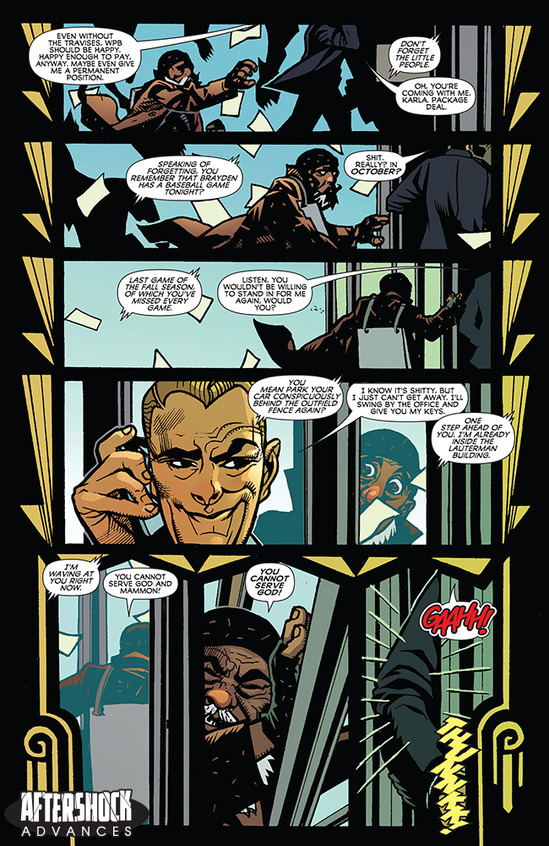
Blood Blister #1 Interior Art by Tony Harris, Eric Layton & Guy Major
Paste: You talked earlier about this book emerging from the experience of being ill. Do you think this is the only story that’s going to result from that, or do you think it might have an impact on other stories that you’re planning to tell?
Hester: There’s always stuff that can pop up. Some things that I thought of when I began this story I had to drop, because they didn’t fit into the story. The best thing about writing a horror book is sitting around, noodling through scary things that could happen to you. In the course of everyday activities, what’s the scariest thing that could happen right now? In the first three or four issues of the book, there’s a lot about Brand Hull being haunted by this stuff that’s burbling up within him, and a lot of the terrifying visions he has. I’m doing a lot of, What’s the scariest thing that could happen right now? Or, What’s the most unsettling thing that could happen right now? Even if that’s going for a run— What’s the most terrifying thing I could see right now, or at least the most creepy thing? Or checking into a hotel. Little stuff like that; where’s the dark corner that this could turn into? That’s a fun exercise. I don’t get to use all of them, but it’s a fun way to write a horror book. And it can take you down different avenues that you didn’t expect when you sat down to plot the whole thing.
